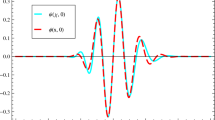Abstract
We perform a quantum information analysis for multi-mode Gaussian approximate position measurements, underlying noisy homodyning in quantum optics. The “Gaussian maximizer” property is established for the entropy reduction of these measurements which provides explicit formulas for computations of their maximum information gain or entanglement-assisted capacity. The case of one mode is discussed in detail.

Similar content being viewed by others
Notes
We denote \(\mathrm {Sp}\) trace of matrices as distinct from the trace of operators in \({\mathcal {H}}\) and \(I_{2s}\) the unit \(2s\times 2s\)-matrix.
We denote by \(I_{s}\) the unit \(s\times s-\)matrix.
References
Barchielli, A., Lupieri, G.: Instruments and mutual entropies in quantum information. Banach Center Public. 73, 65–80 (2006)
Berta, M., Renes, J.M., Wilde, M.M.: Identifying the information gain of a quantum measurement. IEEE Trans. Inform. Theory 60(12), 7987–8006 (2014)
Caves, C.M., Drummond, P.D.: Quantum limits on bosonic communication rates. Rev. Mod. Phys. 68(2), 481–537 (1994)
De Palma, G., Mari, A., Giovannetti, V., Holevo, A.S.: Normal form decomposition for Gaussian-to-Gaussian superoperators. J. Math. Phys. 56(5), 052202 (2015)
Hall, M.J.W.: Quantum information and correlation bounds. Phys. Rev. A 55, 1050–2947 (1997)
Holevo, A.S.: Information capacity of quantum observable. Problems Inform. Transm. 48(1), 1–10 (2012). arXiv:1103.2615
Holevo, A.S.: Quantum Systems, Channels, Information: A Mathematical Introduction, 2nd edn. De Gruyter, Berlin (2019)
Holevo, A.S.: Gaussian maximizers for quantum Gaussian observables and ensembles. IEEE Trans. Inform. Theory 66, 5634-5641 (2020)
Holevo, A.S., Kuznetsova, A.A.: Information capacity of continuous variable measurement channel. J. Phys. A: Math. Theor. 53, 175304 (2020)
Holevo, A.S., Kuznetsova, A.A.: The information capacity of entanglement-assisted continuous variable measurement. J. Phys. A Math. Theor. 53, 375307 (2020)
Kuznetsova, A.A., Holevo, A.S.: Coding theorems for hybrid channels. Theory Probab. Appl. 58(2), 298–324 (2013)
Kuznetsova, A.A., Holevo, A.S.: Coding theorems for hybrid channels. II. Theory Probab. Appl. 59(1), 145–154 (2015). arXiv:1408.3255
Ozawa, M.: On information gain by quantum measurements of continuous observables. J. Math. Phys. 27(3), 759–763 (1986)
Serafini, A.: Quantum Continuous Variables: A Primer of Theoretical Methods. CRC Press, Boca Raton (2017)
Shirokov, M.E.: Entropy reduction of quantum measurements. J. Math. Phys. 52(5), 052202 (2011)
Winter, A., Massar, S.: Compression of quantum measurement operations. Phys. Rev. A 64, 012311 (2001)
Author information
Authors and Affiliations
Corresponding author
Additional information
Publisher's Note
Springer Nature remains neutral with regard to jurisdictional claims in published maps and institutional affiliations.
The work was supported by the grant of Russian Science Foundation (Project No. 19-11-00086).
Appendix
Appendix
The kernel of a Gaussian density operator \(\rho _{m,\alpha }\) with the mean \( m_{q},m_{p}\) and the covariance matrix (7) in the Schrödinger representation has the form
where
Proof
The quantum characteristic function of \(\rho _{m,\alpha }\) is
where
and \(W(x,y)=e^{ix^{t}y/2}e^{ix^{t}q}e^{iy^{t}p}\) is the Weyl operator. The kernel of the Weyl operator is
Here, we introduced the variables \(u=\frac{\xi +\xi ^{\prime }}{2}\), \(v=\xi ^{\prime }-\xi \). Using the inversion formula for the quantum Fourier transform, we readily compute the kernel of the Gaussian state:
the expression under the exponent expands as
Taking the s-dimensional Gaussian integral yields
where \(\mu (m;\xi ,\xi ^{\prime })\) and \(\theta (\xi ,\xi ^{\prime })\) are given by (40) and (41).
Rights and permissions
About this article
Cite this article
Holevo, A.S., Yashin, V.I. Maximum information gain of approximate quantum position measurement. Quantum Inf Process 20, 97 (2021). https://doi.org/10.1007/s11128-021-03046-8
Received:
Accepted:
Published:
DOI: https://doi.org/10.1007/s11128-021-03046-8




